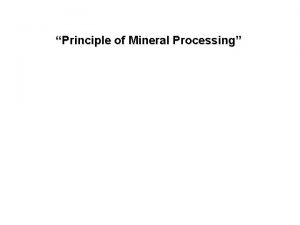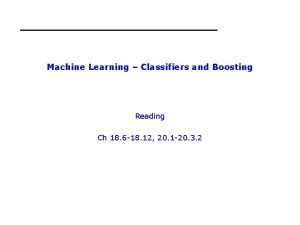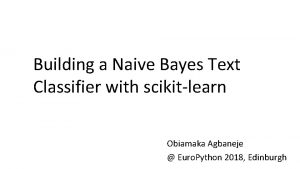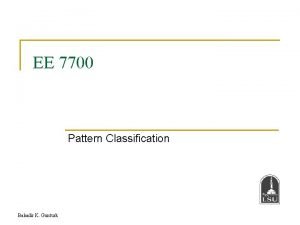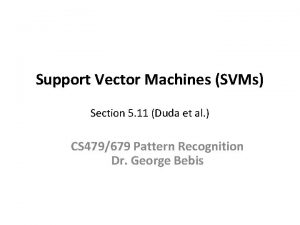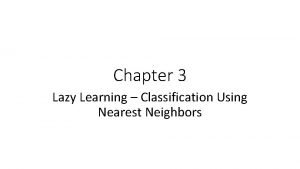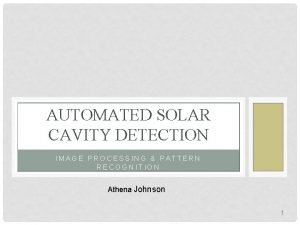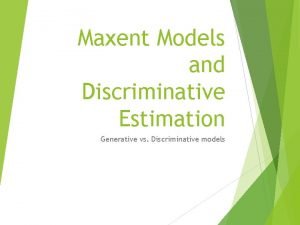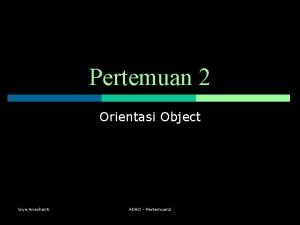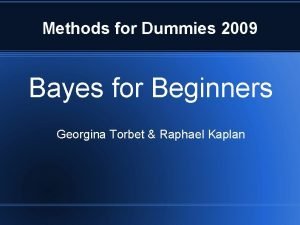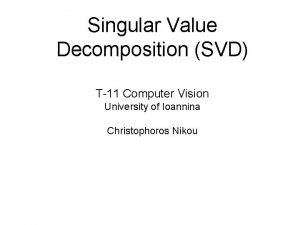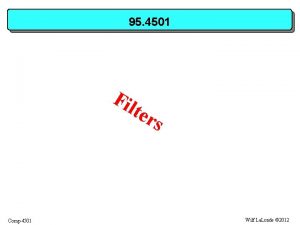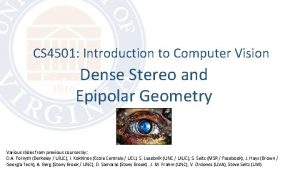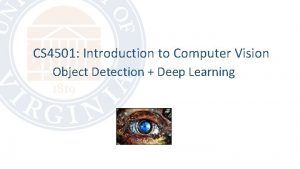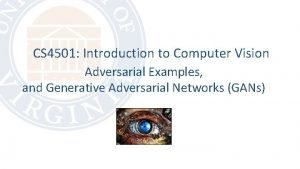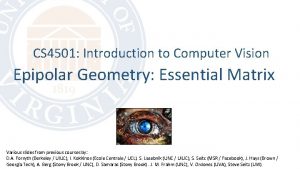CS 4501 Introduction to Computer Vision MaxMargin Classifier






![Linear – Max Margin Classifier - Inference [1 0 0] 7 Linear – Max Margin Classifier - Inference [1 0 0] 7](https://slidetodoc.com/presentation_image_h2/95d2b9f9b4f92fb0df037c25c3440ed6/image-7.jpg)
![Training: How do we find a good w and b? [1 0 0] We Training: How do we find a good w and b? [1 0 0] We](https://slidetodoc.com/presentation_image_h2/95d2b9f9b4f92fb0df037c25c3440ed6/image-8.jpg)





















- Slides: 29

CS 4501: Introduction to Computer Vision Max-Margin Classifier, Regularization, Generalization, Momentum, Regression, Multi-label Classification / Tagging

Previous Class • Softmax Classifier • • Inference vs Training Gradient Descent (GD) Stochastic Gradient Descent (SGD) mini-batch Stochastic Gradient Descent (SGD)

Previous Class • Softmax Classifier • • Inference vs Training Gradient Descent (GD) Stochastic Gradient Descent (SGD) mini-batch Stochastic Gradient Descent (SGD) • Generalization • Regularization / Momentum • Max-Margin Classifier • Regression / Tagging

(mini-batch) Stochastic Gradient Descent (SGD) Initialize w and b randomly For Softmax Classifier for e = 0, num_epochs do for b = 0, num_batches do Compute: Update w: and Update b: Print: end // Useful to see if this is becoming smaller or not. 4

Supervised Learning –Softmax Classifier Extract features Run features through classifier Get predictions 5

Linear Max Margin-Classifier Training Data inputs targets / labels / ground truth predictions [1 0 0] [4. 3 -1. 3 1. 1] [0 1 0] [0. 5 5. 6 -4. 2] [1 0 0] [3. 3 3. 5 1. 1] [0 0 1] [1. 1 -5. 3 -9. 4] . . . 6
![Linear Max Margin Classifier Inference 1 0 0 7 Linear – Max Margin Classifier - Inference [1 0 0] 7](https://slidetodoc.com/presentation_image_h2/95d2b9f9b4f92fb0df037c25c3440ed6/image-7.jpg)
Linear – Max Margin Classifier - Inference [1 0 0] 7
![Training How do we find a good w and b 1 0 0 We Training: How do we find a good w and b? [1 0 0] We](https://slidetodoc.com/presentation_image_h2/95d2b9f9b4f92fb0df037c25c3440ed6/image-8.jpg)
Training: How do we find a good w and b? [1 0 0] We need to find w, and b that minimize the following: Why this might be good compared to softmax? 8

Regression vs Classification Regression • Labels are continuous variables – e. g. distance. • Losses: Distance-based losses, e. g. sum of distances to true values. • Evaluation: Mean distances, correlation coefficients, etc. Classification • Labels are discrete variables (1 out of K categories) • Losses: Cross-entropy loss, margin losses, logistic regression (binary cross entropy) • Evaluation: Classification accuracy, etc.

Linear Regression – 1 output, 1 input

Linear Regression – 1 output, 1 input Model:

Linear Regression – 1 output, 1 input Model:

Linear Regression – 1 output, 1 input Model: Loss:

Quadratic Regression Model: Loss:

n-polynomial Regression Model: Loss:

Taken from Christopher Bishop’s Machine Learning and Pattern Recognition Book. Overfitting Underfitting High Bias Overfitting High Variance

Detecting Overfitting • Look at the values of the weights in the polynomial

Recommended Reading • http: //users. isr. ist. utl. pt/~wurmd/Livros/school/Bishop%20%20 Pattern%20 Recognition%20 And%20 Machine%20 Learning%20%20 Springer%20%202006. pdf Print and Read Chapter 1 (at minimum)

More … • Regularization • Momentum updates 19

Regularization • Large weights lead to large variance. i. e. model fits to the training data too strongly. • Solution: Minimize the loss but also try to keep the weight values small by doing the following: minimize

Regularization • Large weights lead to large variance. i. e. model fits to the training data too strongly. • Solution: Minimize the loss but also try to keep the weight values small by doing the following: minimize Regularizer term e. g. L 2 - regularizer

SGD with Regularization (L-2) Initialize w and b randomly for e = 0, num_epochs do for b = 0, num_batches do Compute: Update w: and Update b: Print: end // Useful to see if this is becoming smaller or not. 22

Revisiting Another Problem with SGD Initialize w and b randomly for e = 0, num_epochs do for b = 0, num_batches do Compute: Update w: and Update b: Print: end // Useful to see if this is becoming smaller or not. 23

Revisiting Another Problem with SGD Initialize w and b randomly for e = 0, num_epochs do for b = 0, num_batches do Compute: Update w: Update b: Print: end and This could lead to “unlearning” what has been learned in some previous steps of training. // Useful to see if this is becoming smaller or not. 24

Solution: Momentum Updates Initialize w and b randomly for e = 0, num_epochs do for b = 0, num_batches do Compute: Update w: Update b: Print: end and Keep track of previous gradients in an accumulator variable! and use a weighted average with current gradient. // Useful to see if this is becoming smaller or not. 25

Solution: Momentum Updates Initialize w and b randomly for e = 0, num_epochs do for b = 0, num_batches do Compute: Update w: Print: end Keep track of previous gradients in an accumulator variable! and use a weighted average with current gradient. // Useful to see if this is becoming smaller or not. 26

More on Momentum https: //distill. pub/2017/momentum/


Questions? 29
 Structured light
Structured light Classification in mineral processing
Classification in mineral processing Perceptron classifier
Perceptron classifier Naive bayes scikit learn
Naive bayes scikit learn Bayes optimal classifier example
Bayes optimal classifier example Pengenalan pola dapat muncul dalam bentuk.... *
Pengenalan pola dapat muncul dalam bentuk.... * Minimum distance classifier
Minimum distance classifier Nearest neighbour classifier
Nearest neighbour classifier Minimum distance classifier
Minimum distance classifier Nearest neighbour classifier
Nearest neighbour classifier Cat dog classifier
Cat dog classifier Svm classifier
Svm classifier Naive bayes classifier
Naive bayes classifier Learning classifier system
Learning classifier system Lazy learning knn
Lazy learning knn Classifier
Classifier Discriminative classifier
Discriminative classifier Adaboost classifier
Adaboost classifier Senior executive classifier
Senior executive classifier Hubungan realisasi khusus antara classifier dan interface
Hubungan realisasi khusus antara classifier dan interface Bayesian for dummies
Bayesian for dummies Cmu 16-385
Cmu 16-385 Kalman filter computer vision
Kalman filter computer vision T11 computer
T11 computer Berkeley computer vision
Berkeley computer vision Multiple view geometry in computer vision
Multiple view geometry in computer vision Font detector
Font detector Radiometry in computer vision
Radiometry in computer vision Linear algebra for computer vision
Linear algebra for computer vision Computer vision
Computer vision

